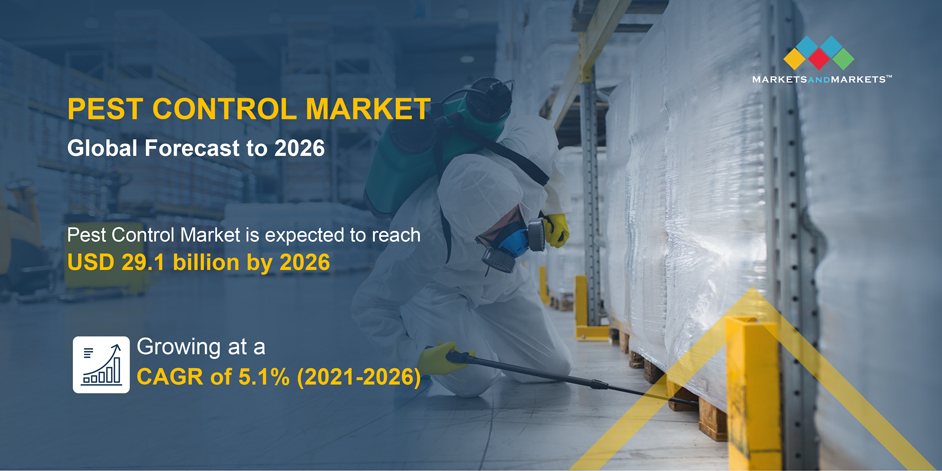MarketsandMarkets forecasts the pest control market to grow from USD 20.5 billion in 2019 to USD 27.5 billion by 2025, at a CAGR of 5% during the forecast period. The market is primarily driven by chemical pest control techniques due to the high demand for insecticide solutions across the globe by service providers. The increasing awareness of public health has compelled the people to adopt pest control services on a regular basis at residential and commercial levels. The objective of the report is to define, describe, and forecast the pest control market size based on pest type, control method, mode of application, application, and region.

Insects are the major pest type driving the growth of pest control market during the forecast period.
The insects segment dominated the pest control market due to the high prevalence of insects such as bedbugs, flies, mosquitoes, and wasps. The prevalence of insects is high in all the regions; hence, the demand for pest control for insects is high, globally. According to the World Health Organization, mosquito bites result in the deaths of more than 1 million people, every year; the majority of these deaths are due to malaria. Therefore, pest control is largely carried out to eradicate/kill mosquitoes. As per the UK Climate Projections 2018 study, the summer temperatures could be 5.40C hotter by 2070. With climate change and rise in temperature, the population of flies is projected to increase by 244% from 2015 to 2080, according to the World Health Organization (WHO). This, in turn, is projected to increase the demand for insect pest control in the Europe. Thus, rising temperature is one of the major factor for increased prevalence of insects and thus increasing demand for insect pest control globally.
Download PDF Brochure: https://www.marketsandmarkets.com/pdfdownloadNew.asp?id=144665518
By application, the residential segment dominated the pest control market in 2018.
The residential segment is projected to exhibit a strong potential for pest control service providers, which is mainly driven by the middle-class population and increased purchasing power parity. The increasing population density, climate change, and growing economic activities can lead to a lack of resources and amenities to avert or reduce pollution risks. In addition, improper sanitary procedures and inefficient implementation processes for public health hygiene are projected to cause health risks in the residential sector. The residential segment mainly witnesses a surge in demand for pest control services for the containment of cockroaches, bed bugs, mosquitoes, and termites.
Growth in pest resistance against chemical compounds
Even though insects are effectively controlled by the application of chemicals, these insect species have the ability to develop resistance to insecticides when exposed to a larger dose of these active ingredients frequently. For instance, flies are known to have developed high resistance against all types of insecticides due to the improper handling of pesticides. According to the Center for Integrated Pest Management, over 600 species of pests have developed resistance to chemical compounds. This has prompted the use of biocontrol products and alternative measures including crop rotation to prevent pests from building any resistance
In Japan and Hawaii, the diamondback moth had developed resistance against Bacillus thuringiensis due to lack of awareness on the dosage level and application technique. Increase in incidences of insect resistance and high R&D costs are expected to inflate the final price of the new generation of insecticides. These new-generation compounds can also turn into another ineffectual material when the insects develop resistance at a higher rate. The usage of plant-derived chemicals, adoption of integrated pest management practices, and availing the services of pest management professionals can lower the risks of insecticide resistance.
China is projected to witness the highest growth in the Asia Pacific pest control market by 2025.
The Asia Pacific pest control market is projected to witness significant growth in China, as the development of megacities in Beijing, Shenzen, and Chongqing has marked a significant increase in the pest population in the urban areas. China is the largest consumer of pest control in Asia Pacific and has a subtropical climate with hot summers and cold winters, which are ideal conditions for insect proliferation. The global market in India is also projected to witness significant growth during the forecast period, as large players such as Rentokil Initial (UK) continue to expand their presence in the market through acquisitions. The Indian market for pest control sees heavy demand for controlling pests such as insects and rodents in densely populated urban areas.
This report includes a study of the development strategies, along with the product portfolios of leading companies. It also includes the profiles of leading pesticide suppliers such as Bayer CropScience (Germany), Syngenta AG (Switzerland), BASF (Germany), and UPL Ltd. (India). The leading service providers in the Indian market include Rentokil PCI (India), Truly Nolen (US), HiCare Pest Control, Pestron India (India), and Orkin (US).
Request Sample Pages of the Report: https://www.marketsandmarkets.com/requestsampleNew.asp?id=144665518
Recent Developments:
- In March 2019, DowDuPont confirmed the completion of the required clearances for the spin-off for Corteva Agrisciences (US) which would operate as a separate company under the conglomerate.
- In January 2019, Control Solutions Inc. (US), a wholly owned subsidiary of Adama, acquired Bondie Products Inc. (US). The acquisition is expected to benefit CSI through the access of Bondie’s portfolio of pest control products and customer base.
- In October 2018, Bell Laboratories launched Contrac Soft bait 4lb pails, for the US market following the success of its 16lb pails. The new product is expected to ease mobility concerns for service technicians on the field as well as ease inventory management for service providers.
- In July 2018, Rollins, Inc. acquired Aardwolf Pestkare (Singapore) Pte Ltd., a pest control company in Singapore. This acquisition helped Rollins, Inc. to expand its market presence in the Asia Pacific region.

